D.I.Y. Tips & Tricks.
Casting a Lap!

This mold has machined grooves to make a ribbed lap. The ribs which will be on the bottom of the lap stiffen and lighten it and to conserve material. A plain pan will serve as well for a simple solid lap. Note the round dowel inseted into a bore in the mold to cast the mounting hole. This is not neccesary, as the hole can be bored later, but it serves as a center reference.
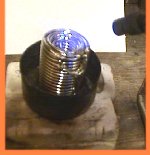
Melting the alloy..In this case, my favorite, 95% Tin/5% Antimony. Pewter, type metal, other solders all work as well. Nothing fancy here..a torch and an old Cat Food can!
Preheat the mold...
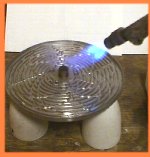 >
>
...and pour.

Bump the table so bubbles escape. Note the mold is set on three inverted crucibles, but firebrick, etc. works fine. DON'T bang the table so hard the mold falls over and dumps metal all over your feet. (Don't ask.) :-)
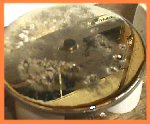
The mold is filled with molten metal.

When the metal has solidified the casting can be quenched with a wet cloth. This quench can make a finer grain structure than if the metal had cooled slowly.
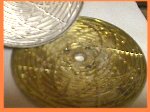
Remove the casting from the mold. I tapped three 1/4-20 extractor screws to make it easy. They will jack the casting out. If you use a simple pan they are not needed.
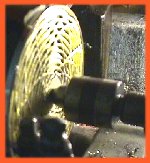
Mounted with double-sided tape, the back is machined,
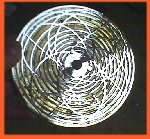
then the lap is removed and the front machined...
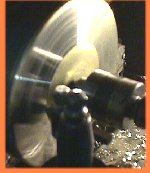
And it's done!

Plumbers, bullet casters, fishermen who cast their own sinkers, etc. have no trouble casting these.



This mold has machined grooves to make a ribbed lap. The ribs which will be on the bottom of the lap stiffen and lighten it and to conserve material. A plain pan will serve as well for a simple solid lap. Note the round dowel inseted into a bore in the mold to cast the mounting hole. This is not neccesary, as the hole can be bored later, but it serves as a center reference.

Melting the alloy..In this case, my favorite, 95% Tin/5% Antimony. Pewter, type metal, other solders all work as well. Nothing fancy here..a torch and an old Cat Food can!
Preheat the mold...
 >
>
...and pour.

Bump the table so bubbles escape. Note the mold is set on three inverted crucibles, but firebrick, etc. works fine. DON'T bang the table so hard the mold falls over and dumps metal all over your feet. (Don't ask.) :-)

The mold is filled with molten metal.

When the metal has solidified the casting can be quenched with a wet cloth. This quench can make a finer grain structure than if the metal had cooled slowly.

Remove the casting from the mold. I tapped three 1/4-20 extractor screws to make it easy. They will jack the casting out. If you use a simple pan they are not needed.

Mounted with double-sided tape, the back is machined,

then the lap is removed and the front machined...

And it's done!

Plumbers, bullet casters, fishermen who cast their own sinkers, etc. have no trouble casting these.
